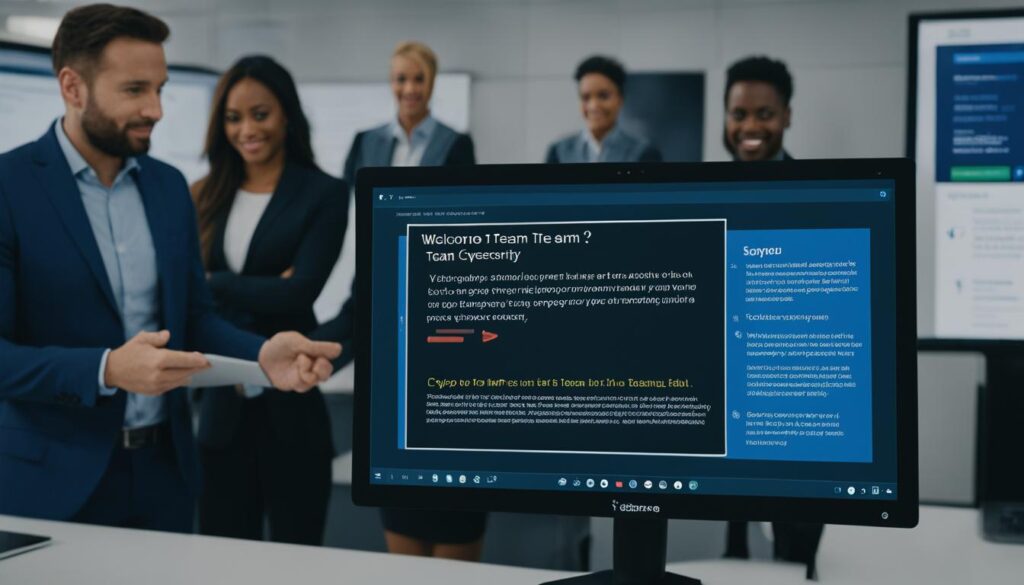Did you know that 15% of companies continue the onboarding process even after six months? This surprising statistic reveals the significant amount of time it takes to complete employee onboarding paperwork. Furthermore, studies show that 90% of employees make their decision to stay or leave within the first six months of their employment. This emphasizes the importance of a comprehensive onboarding program that extends beyond the initial phases.
Key Takeaways:
- The average duration for completing employee onboarding paperwork should ideally be three to six months.
- An extended onboarding program that lasts the entire first year of employment can improve job satisfaction and overall performance.
- Many companies devote only about a month to onboarding new hires, which may not provide enough time for a thorough and personalized experience.
- The onboarding process should start before the employee’s first day and involve preparing the necessary paperwork and logistical details.
- The training period and first week should focus on providing support and helping the new hire acclimate to their role and work environment.
The Onboarding Process: Preparing for Day One
The onboarding process is a crucial step in ensuring the success and satisfaction of new employees. It begins even before their official start date during the pre-boarding phase. During this phase, HR and the manager work together to prepare for the new hire’s arrival.

Before the new employee’s first day, HR and the manager would order any necessary equipment, access badges, and provide logistical details. This not only ensures a smooth transition but also helps the new hire feel welcomed and valued from the start.
Additionally, the pre-boarding phase allows for personalization. It is an opportunity to address any questions or concerns the new hire may have before their first day. This includes providing information about the dress code, company policies, and any other relevant details that can help ease their transition.
Another advantage of the pre-boarding phase is the opportunity to complete some paperwork in advance. By taking care of new hire paperwork before the first day, it allows the new employee to focus on getting to know their colleagues, familiarizing themselves with their new work environment, and diving into their job responsibilities.
First Day Orientation
On the first day, it is crucial to create a positive and welcoming experience for the new employee. The day should begin with setting clear expectations and goals for their role within the company. This helps the new hire understand their responsibilities and sets them up for success.
Introducing the new employee to their co-workers and providing necessary equipment, such as a computer or workspace, is also essential. This facilitates relationship-building and ensures that the new hire has the tools they need to start their work effectively.
Furthermore, the first day orientation should include going over relevant HR procedures and company policies. This ensures that the new employee is familiar with the guidelines and expectations of the organization.
By prioritizing the pre-boarding phase and creating a comprehensive first day orientation, companies can establish a solid foundation for the onboarding process. This sets new hires up for success and helps integrate them seamlessly into the company culture.
The Training Period and First Week
After the initial onboarding day, you will enter into the training period to get up to speed and prepare for your role on the team. This phase is crucial in equipping you with the necessary knowledge and skills to excel in your new position. During this time, you will have the opportunity to familiarize yourself with the company’s onboarding orientation program and employee handbook, which contain valuable information about company policies, procedures, and expectations.
Training during the first week should strike a balance between providing support and ensuring your comfort while avoiding overwhelming you with too much information all at once. A well-designed training program will deliver the necessary information in a digestible manner, allowing you to gradually absorb and apply what you’ve learned.
Throughout your first week, it is important to schedule regular check-ins with your manager. These check-ins serve as an opportunity to address any concerns or questions you may have, assess your progress, and provide feedback. Your manager will play a crucial role in guiding your development and ensuring your successful integration into the team.
By the end of your first week, you should have a good understanding of your role and feel acclimated to your work environment. You will have gained valuable knowledge and skills that will lay the foundation for your success within the company.
During this initial training period, it is important to remember that the mentorship process plays a vital role in your onboarding journey. Mentors can provide guidance, support, and valuable insights as you navigate your new role. The mentorship process fosters professional growth and accelerates your integration into the team, ensuring you feel supported and included.
As you progress through the training period and first week, make sure to take advantage of any opportunities for continuous learning. This could include attending workshops, webinars, or additional training sessions that will further enhance your skills and knowledge. Embrace a growth mindset and seek out opportunities to develop both personally and professionally within your new role.
Building Relationships and Expanding Knowledge
During the second month of employment, it’s important for new hires to focus on building relationships with team members and across different departments. This allows them to gain a better understanding of the company culture and how things operate. By actively engaging with colleagues, they can forge meaningful connections and establish a strong network within the organization.
The manager plays a crucial role in facilitating this process. Regular discussions about the employee’s experiences and performance provide valuable opportunities for feedback and ensure that their expectations align with their actual experiences. This ongoing dialogue enables the manager to address any concerns promptly and create a supportive environment for the new hire.
As the third month approaches, the employee should start feeling more acclimated and confident in their role. They should be able to autonomously handle projects and contribute to the success of their team. This is a pivotal time to encourage continuous learning and professional growth.

To foster continuous learning, consider implementing mentorship programs or providing access to online resources and training materials. By encouraging employees to expand their knowledge and skills, you create an environment that values personal development and keeps everyone engaged.
Furthermore, this is an opportune moment to discuss career progression. By involving the employee in their own development plan, you empower them to take ownership of their career trajectory and set goals for the future. This not only benefits the individual employee but also contributes to the overall success of the company.
In summary, the second and third months of employment are crucial for building strong relationships, understanding the company culture, and encouraging continuous learning. By prioritizing these aspects, you foster employee engagement, create a positive work environment, and set the stage for long-term success.
Long-Term Engagement and Continuous Improvement
The onboarding process is not just a one-time event that lasts for a few weeks or months. It extends beyond the initial period and is crucial for maintaining employee engagement and ensuring long-term satisfaction. To achieve this, regular check-ins with the manager are essential. These check-ins provide an opportunity to assess the employee’s progress, address any concerns, and gather feedback.
Collecting feedback from the new hire is a valuable practice that helps identify areas for improvement in the onboarding program. By actively listening to their input and suggestions, you can enhance the onboarding experience and tailor it to better fit the unique needs and culture of your organization.
Remember, onboarding is an ongoing process. It requires adaptability and continuous improvement. By prioritizing employee retention, shaping a positive company culture, and providing a fulfilling employee experience, you can create a strong onboarding procedure that sets new employees up for long-term success. Investing in a comprehensive and personalized onboarding program demonstrates your commitment to employee development and fosters a sense of belonging from day one.




